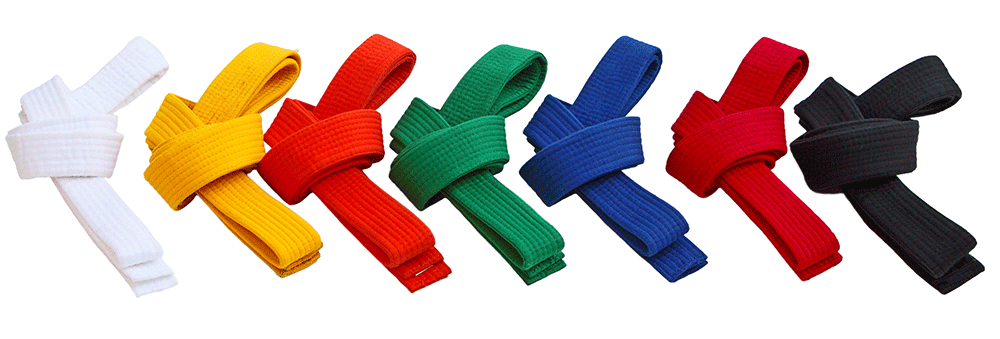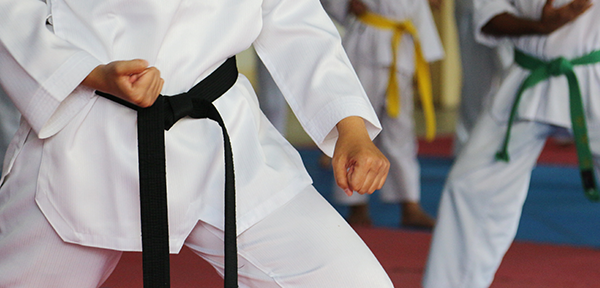It’s hard to think of a more famous ranking system in sport than that of the belts used to signify a student’s level of training in martial arts.
Today, the term ‘black belt’ has transcended the likes of judo and karate, and taken on a meaning of its own in popular culture. But what IS a back belt, and how did it become such a well known symbol? The black belt is the highest coloured belt within many Martial Arts ranking formats, so logically its very mention conjures images of experts punching through bricks and kicking through thick strips of wood.
But to think of a black belt holder as somebody who has mastered their particular concentration isn’t quite right. To look deeper at what black belts actually signify, let’s explore the history of these world-famous coloured belts:

Coloured belt origins
Why are the colours of belts ordered in a way that progresses from light to dark colours? One popular explanation originates, improbably, from the world of washing and cleanliness. After training, a student would wash all of their uniform – except for their belt. As they attended more martial arts classes they would continue to leave their belt while washing their clothes, causing its initial white appearance to become more yellow, before more wear and tear would tinge their belt green. Eventually after excessive use – and therefore practice – the student’s belt would appear more brown before eventually taking on a fully black visage as their training continued to run its course.
This origin story is beautiful – if not slightly unhygienic. It’s also probably false. Although this doesn’t stop many practitioners from latching on to this tradition in order to illustrate their commitment to training through a rugged and worn old belt.
Martial arts black belts help to ignite our imaginations and conjure images of students partaking in ancient combat as part of their training – but in reality, the coloured belt ranking system has its origins dating back to the turn of the 20th Century, as opposed to ancient times.
Many martial arts as we know them today adopt the kyu/dan system of coloured belts (kyu signifying colour belts and dan signifying the black belt). This system was devised by Jigoro Kano, a Japanese martial artist who aimed to repurpose the battlefield arts of jujitsu and aikijutsu into a safe concentration to turn into a sport that could be practised by all: judo was born, and quickly introduced into schools and colleges nationwide.
The vast quantities of different aged students studying judo from different learning environments meant that a well-structured ranking system had to be devised in order to ensure everybody could compete at a level that suited them while gauging their own progress. Thus, Kano came up with the coloured belt systemwe know today.

The significance of the black belt
On the significance of attaining a black belt in martial arts, Bruce Lee reportedly said that they are “nothing more than a strip of cloth to hold your pants up.”
Taken at face value, Lee could be interpreted as panning the entire notion of the famous martial arts ranking system. But it’s more likely that he was rather highlighting the fact that the black belt doesn’t signify mastery in a concentration. It’s certainly a significant milestone, but also simply means that you’re prepared to continue your journey of learning and discovery.
Today we’re used to convenience and material joy. The black belt stands as an increasingly profound antidote to this mindset, with students having to master the art of patience and humility as well as combat. Herein lies the important role of the sensei (teacher), while it’s the task of the individual to earn belts, it is the job of the sensei to award them where they see fit. Overconfidence, showboating and a lack of respect may not show a lack of training, but a sensei could interpret such actions as a flaw in the character of the student. Becoming a black belt is so much more than simply performing well when in a combat situation.
In judo the first level of black belt is known as shodan, meaning ‘first level’. This is an ideograph that’s comprised of two radicals signifying ‘cloth’ and ‘knife’. When you make a piece of clothing, you must first cut a pattern out of the cloth – if there’s an early error, this will undermine your entire finished piece of clothing and it won’t fit properly. Similarly, your training to reach black belt is vital in paving the way for how you will eventually turn out as a black belt.
If you’re careful, conscientious and committed, your training will have paved the way to becoming a great black belt, but as shodan indicates, this is just the beginning. Being a black belt is a massive achievement, but you need to use it to continue your learning or run the risk of it becoming nothing more than a strip of cloth.


